Composite Flexible Pipe: Enabling the Next Generation of Dynamic Riser Systems
Composites materials have been used in the oil and gas industry for the last thirty years and are constantly evolving with new materials and technology [1]. Beyond the materials developments, there has been steady progress on qualification of the technology for even more demanding applications. One application, which will be discussed in this article, is the use of composite technology in unbonded flexible pipe for dynamic risers to connect floating production facilities to seabed flowlines.

31 Mar 2021
Author
Nitin Repalle
Principal Flexible Riser Engineer, Perth
Rohit Shankaran
Principal Engineer, Houston
Pedro Viana
Flexibles Engineering Manager, Woking

Traditional Flexible Pipe – An Overview
The multi-layer design of a flexible pipe structure facilitates low bending stiffness as opposed to axial tensile stiffness, allowing a much smaller curvature radius than a rigid pipe. This gives flexible pipe several advantages over rigid risers such as reduced transport and installation costs due to prefabrication and storage on reels. They are compatible with dynamic structures and allow a permanent connection between a floating support vessel and subsea equipment enabling a wider range of applications than any other pipe technology.

While a flexible pipe is bespoke and designed to suit the field conditions, uncertainty in operating conditions and the ageing properties of the polymeric material reduces the functionality of the individual layers and may ultimately lead to failure of the flexible pipe. Each of the layers within the flexible pipe has multiple failure mechanisms.
Failures are typically instigated by extreme loads or fatigue caused by repeated cyclic motions of the flexible pipe as a result of waves and vessel motions. A fatigue failure could be accelerated by rupture of the outer sheath and ingress of seawater, or by the permeation of gases from the internal fluid into the armour annulus environment where condensation of water vapour will also help develop a corrosive environment.
The use of carbon steel for the pressure and tensile armour in the flexible pipe structure contributes significantly to a riser’s weight. For deep and ultra-deepwater applications, the pipe weight is either a key limitation for the operating envelope of the floating facility or demands bulky topside equipment to support the riser. The likelihood of flexible pipe failure in extreme loads is much higher for deep to ultra-deepwater applications. There are, however, some new technologies being developed that might enable this application.
Thermoplastic Composite Pipe
Thermoplastic composite pipe (TCP) can be used as an alternative to traditional flexible pipe and offers a novel solution to address the shortcomings of a traditional flexible pipe while maintaining most of its advantages. TCP can be considered as a new class of pipe made of three layers: a liner, a composite and a protective layer, bond fused into one solid wall in a curated heating process.

TCP is well suited for offshore applications due to its simple design and offers key advantages over traditional unbonded flexible pipe and rigid pipes, such as:
Corrosion resistance: TCP has greater chemical compatibility with hydrocarbons and being non-metallic, eliminates any corrosion issues.
Fast installation: TCP is lightweight, spoolable on a reel and only requires a small team which facilitates faster installation.
Improved fatigue life: Composites are lightweight and offer high levels of strength and resistance to fatigue damage.
Continuous manufacturing: Continuous lengths greater than 4000m can be manufactured and spooled on reels which reduces transportation costs and installation time.
Reusable & versatile: Similar to flexible pipe, TCP can be reused repeatedly at different locations. End termination of a TCP can also be performed offshore but is much simpler and faster than traditional flexible pipe. This increases its adaptability to change of length requirements or removal of damaged sections.
Two manufacturers lead the thermoplastic composite pipe market for the offshore industry today: Strohm (previously Airborne Oil and Gas), with headquarters in the Netherlands, and Magma Global, based in the UK.
Strohm initially developed TCP for power and data transmission and then further extended the technology to manufacture jumpers, flowlines and risers. Depending on the design environment, Strohm offers a combination of glass, carbon fibre with PE, PA12 and PVDF polymer matrix. They recently qualified carbon fibre-PVDF composite for high-temperature and pressure applications and are currently qualifying TCP for riser applications [2].
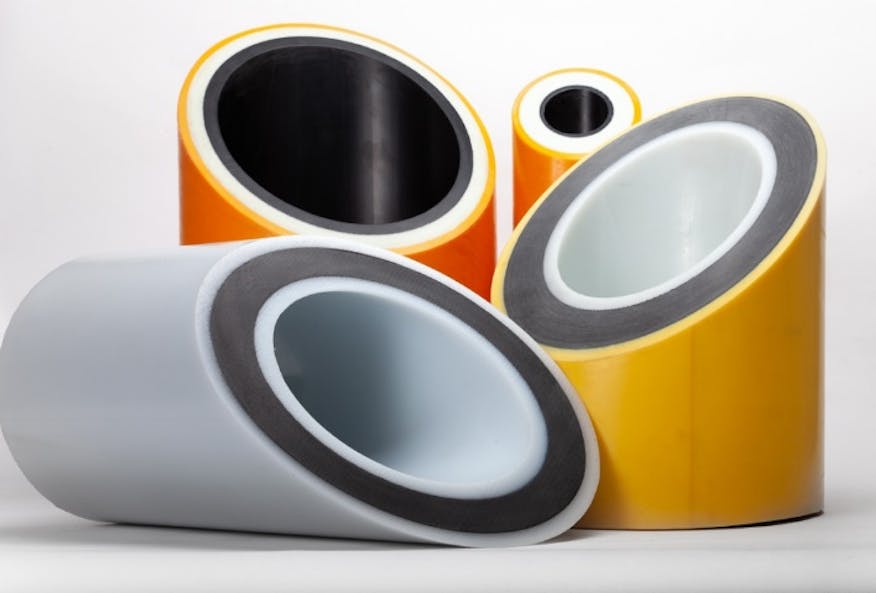
Strohm TCP
Magma Global, founded in 2010, opened its production site in Portsmouth, U.K., in 2016. The Magma TCP concept is different from the range offered by Strohm. They use different materials, arrangement, manufacturing process and end termination. Magma concentrates on using poly-ether-ether-ketone (PEEK) as the polymer material, reinforced with glass and carbon fibres, and has trademarked it as the “M-pipe”.
While Strohm TCP utilises a range of materials, from low-cost glass and polyethene to high-end carbon fibre and PVDF, Magma employs one product to suit all applications. The advantage of Magma’s PEEK is that it is about 30-100 times less permeable to carbon dioxide, hydrogen sulphide and acids than other polymers materials used for composite pipes [3]. Magma is currently qualifying M-pipe for high temperature (350°F/176°C) and pressure (15ksi/1034bar) [4].
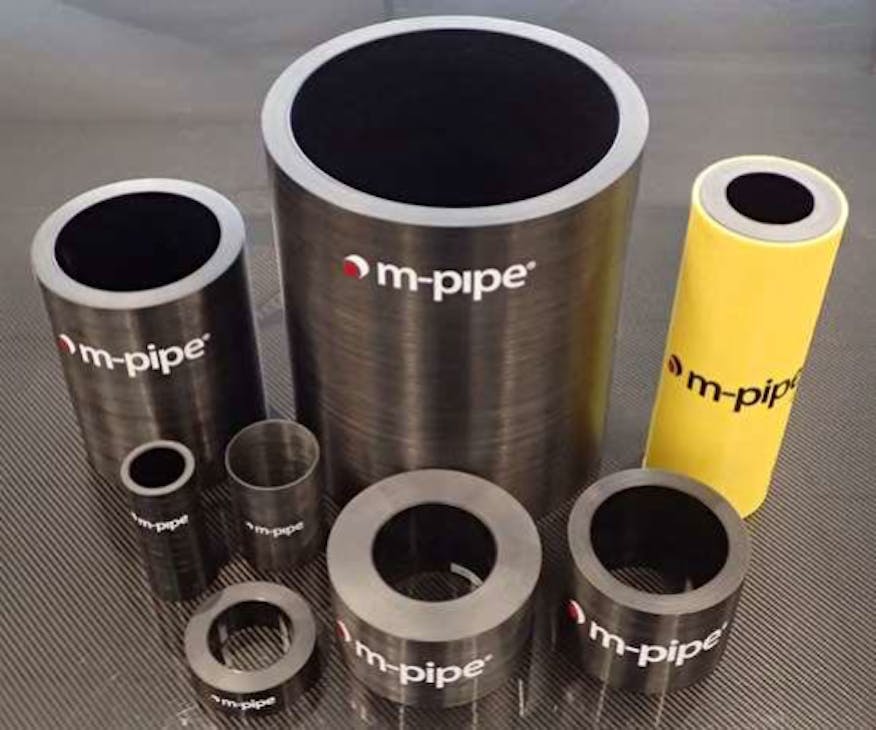
The Emergence of Hybrid Flexible Pipe
Traditional flexible pipe manufacturers like TechnipFMC and Baker Hughes have also been investing in the development of composite technology aiming to replace layers of the flexibles with a composite material to enhance its robustness and certain technical characteristics. The use of rectangular carbon fibre-based composite strips as tensile armour wires were first reported by TechnipFMC in 2013 [5]. They concluded that the mechanical properties of the wires were not affected by corrosive environments containing H2S or CO2. Plus, the wires are elastic in nature and bend more easily than carbon steel wires, resulting in reduced bending stiffness for small curvature.
Baker Hughes introduced hybrid flexible pipe (HFP) with fibre-reinforced composite pressure armour to replace the traditional metallic pressure armour in flexible risers, using carbon fibre reinforced poly-vinylidene thermoplastic polymer composite [6].

Hybrid Flexible pipe from Baker Hughes
In 2018, Technip and Magma announced a collaboration to develop a hybrid flexible pipe by taking advantage of the chemical resistance and fatigue performance of Magma’s high-end carbon fibre + PEEK TCP and the stability and strength of flexible steel armour of the traditional flexible pipe. The carcass, pressure sheath and/or pressure armour from the conventional pipe are replaced with a TCP layer.

Hybrid Flexible Pipe Developed by Technip and Magma
How Do Hybrid Flexible Pipe and Thermoplastic Composite Pipe Compare?
HFP address the shortfalls of TCP but still offers some of the reliability and robustness of traditional flexible pipe. The low weight of TCP is beneficial for handling, packaging and transportation but it is a significant challenge to find a suitable riser configuration and on bottom stability to ensure operational performance. The weight of TCP is about 1/10th the weight of an equivalent flexible pipe, which mitigates issues related to excessive load on the host platform. However, with such low weight, TCP is easily swayed by waves and currents, resulting in large riser motions and lateral deflections. HFP is heavier than TCP and weighs around 30-60% less than traditional flexible pipe, which provides better stability compared to TCP, yet achieves a good compromise in terms of vessel loads.
Another challenge with the TCP is the very large bending radius. TCP has excellent performance against axial loads but is susceptible to failure in bending loads due to the high risk of glass or carbon fibres disengaging from the polymer matrix. TCP, therefore, need bigger reels for storage and installation and also limits the operational envelope. HFP allows for better performance against bending as the composite material can be optimised to provide strength against internal pressure while the carbon steel tensile wires provide the strength against the axial loads.
While TCP and HFP have substantial advantages, they are both limited in their use by the following issues:
High material cost: TCP and HFP are more expensive than traditional flexible pipes and rigid pipes, both from a material and manufacturing point of view. This makes them an expensive option if traditional pipe is well qualified for the design conditions.
Limited track record: Composite pipes are currently limited in terms of pipe diameters, and temperatures. Most of the qualification so far has been aimed at static applications and for dynamic riser applications the qualification is still ongoing and only picked up traction in the last couple of years.
High stiffness and MBR (minimum bend radius): Due to the complex nature of composites, they are characterised with higher bending stiffness and have a larger MBR which implies that composite pipes will need reels with larger drum sizes or carousels for packaging. Due to their lower weight, they are also prone to large deflections which are not favourable for dynamic riser applications.
Is Composite Pipe the Key for Ultra-Deep Water Developments?
As the industry moves more into ultra-deep waters, the weight of the riser becomes an increasing challenge. TCP and HFP offer strong advantages in these scenarios. First, they are considerably lighter than traditional flexible and rigid pipe, meaning that deck space and buoyancy capabilities can be optimised for storage capacity or topsides processing facilities rather than to support heavy risers.
Secondly, increasing depth means increasing pipeline distance from seafloor wellhead to the production riser. This means hydrocarbons must travel considerable distances through the riser in a very low-temperature environment. Cooling of hydrocarbons below a certain temperature (this is called cloud point) leads to wax and hydrate formation. To avoid hydrate formation in the flexibles, insulation layers would need to be added to the pipeline. However, the addition of insulation is not practical and significantly increases the cost of the riser.
TCP is inherently made of polymer materials and offers good insulation properties to a certain level. In addition, the thickness of the polymer could be optimised to meet the required insulation requirements. It is also worth noting that a very low overall heat transfer coefficient (u value) could also be reached, but the cost of TCP may not be cost-effective at that point.
An example where TCP or HFP would have been a good candidate is the BP Thunder Horse project in the Gulf of Mexico [9]. The semi-submersible was built to support the steel catenary riser system and was large enough to create displacement sufficient to counterbalance the significant hang-off load created by the steel riser. It was one of the most expensive facilities in the region, in part due to costly buoyancy and tensioning systems. In many ways, this project was a wake-up call for the industry due to the cost and it highlights that selecting a lighter riser for deepwater projects could save billions of dollars from the platform cost.
Case Study: Comparison of Traditional Flexible Riser, HPF and TCP for an 8” I.D. Pipe for 3000m Water Depth
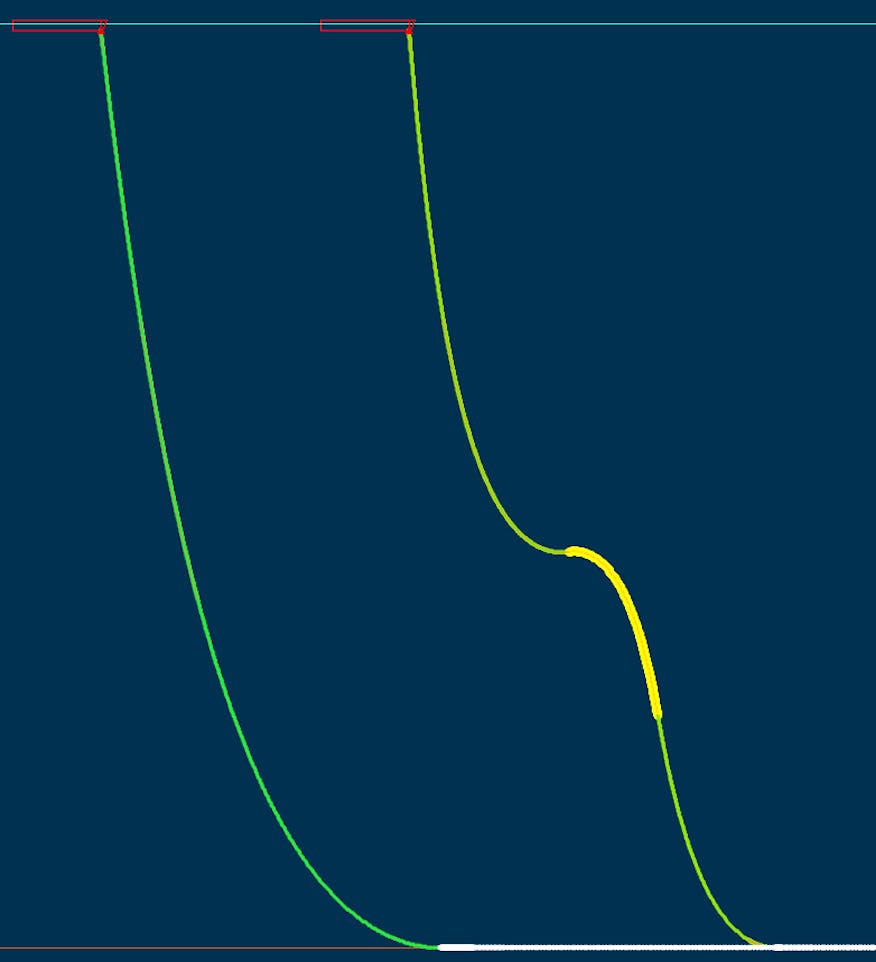
Catenary and Lazy Wave Configurations for Ultra-Deepwater Fields
We compared hang-off loads for static and 100 year return period metocean conditions in the Gulf of Mexico. For a lazy wave configuration, maximum static and dynamic tension were assessed for steel pipe, traditional flexible pipe, HPF and TCP. The tensions for HPF and TCP are on par and are about 50% less than the traditional flexible pipe. In contrast, the lateral deflections for the steel pipe and traditional flexible pipe are the lowest, followed by the HPF and TCP. The lateral displacement for TCP is about 40% larger than the traditional flexible pipe. It is also worth noting that the dynamic amplification factors (DAF) show an increasing trend going from rigid steel pipe to a flexible pipe to HFP and to TCP. An important aspect to note is the mitigation of clashing can be a big challenge for HFP and TCP due to the low weight.
A similar trend is also observed for a simple catenary configuration, with tensions for HPF and TCP showing 50% to 70% less than a traditional flexible pipe. The lateral deflections for TCP pipe is 300%-350% larger than traditional flexible pipe.
As seen in both cases, tension is significantly less for the HFP and TCP, however, the deflections are a major challenge. The deflections can be reduced by adding weight and optimising buoyancy, but there is a trade-off in terms of strength response. While the challenge of finding a workable configuration is real, significant cost benefits can be realised from utilising TCP.
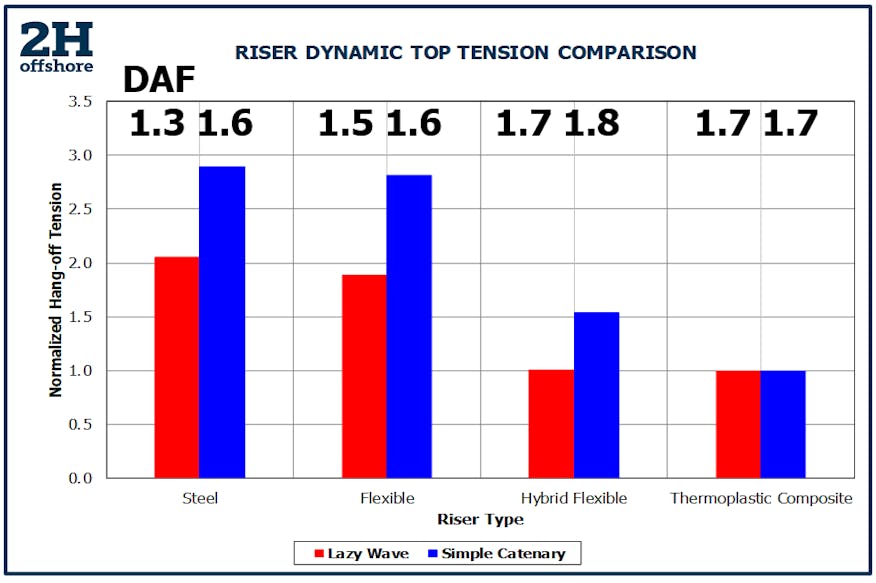
Dynamic Top Tension Comparison
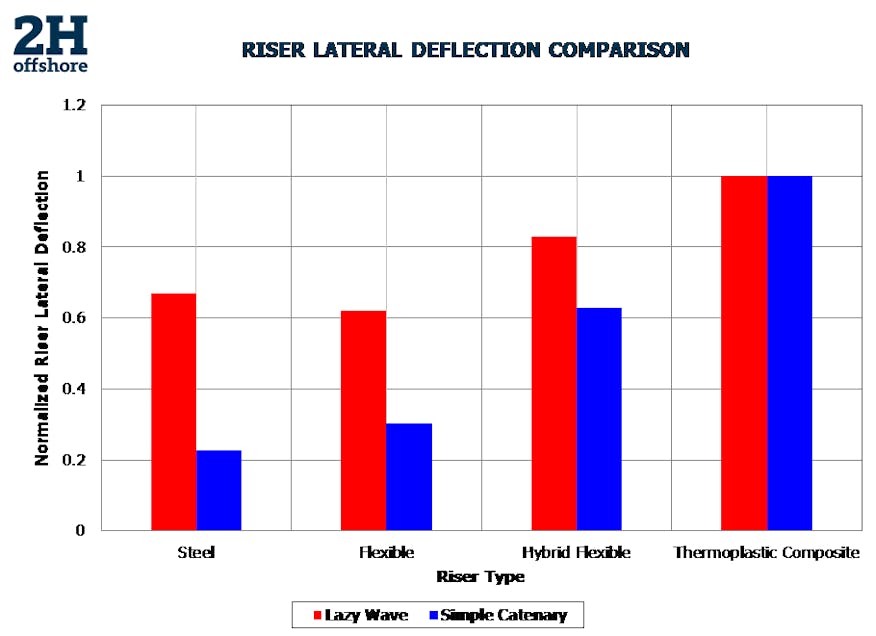
Maximum Riser Lateral Deflections Comparison
Supercritical CO2 – A Challenge for Deep Water Reservoirs with High CO2 Content
Crude oil and natural gas contain various corrosive contaminants such as CO2, H2S, chlorides water vapour, and microbes. When carbon steel components (pressure and tensile armour) get in contact with these, they are prone to corrosion.
Carbon dioxide (CO2) is a principal corroding agent and a recognised problem for flexible pipe assets. The impact of CO2 corrosion on carbon steel has been studied extensively at pressures relevant for oil and gas transport (up to 20 bar CO2). At temperature and pressure of over 31.1°C and 73.8 bar, the CO2 exists in the supercritical stage. CO2 at the supercritical stage (represented as SC-CO2) displays properties midway between a gas and liquid, i.e. has the density of liquid but expands like gas. The interaction of the SC-CO2 with the condensed water is significantly different than the CO2 in a gaseous state. Dissolved SC-CO2 in the produced or condensed water can result in a very high corrosion rate leading to rapid structural degradation and failure of the flexible pipe.
Two re-injection flexible risers installed in the Sapinhoá and Lulu pre-salt field offshore Brazil unexpectedly ruptured in 2016 and 2017 followed by a third one in early 2020 in Santos pre-salt province [10]. These pipes were expected to last more than 20 years but failed in less than 5 years of operation. The high concentration of carbon dioxide is considered to have been the cause for the accelerated corrosion and eventual rupture of the riser tensile armours.

Carbon Dioxide Pressure-Temperature Phase Diagram
In deepwater offshore environments like this, flexible and rigid pipes face a more chemically aggressive environment, including supercritical CO2. Having a suitable mitigation measure to CO2 exposure should be considered and addressed to safeguard assets.
Traditional flexible suppliers and major operators have initiated research to better understand the SC-CO2 phenomenon and are able to design traditional pipe with suitable materials to mitigate corrosion. The SC-CO2 failure mode is now considered at the design stage for all new projects where high levels of CO2 are evident (e.g. Brazil pre-salt region).
Composite pipe, on the other hand, offers a novel approach in addressing the corrosion of carbon steel elements of flexible pipe. TCP consists of layers of composite reinforced with glass or carbon fibres around a polymer liner. Steel components are entirely eliminated and thereby also eliminate any risk of corrosion.
The rate of permeation is also a vital parameter to consider to reduce the effects of corrosion. It was proven by a large-scale test of flexible pipe that at 100°C and 50 bar in the presence of CH4 and CO2 gases [11], the permeation of CO2 is more than CH4. Composite layers are much more efficient at reducing the permeation of the CO2 into the annulus than just a polymer layer so utilising composite technology in HFP benefits in two folds. First, the pressure armour is replaced with a bond-fused composite layer eliminating the risk of pressure armour corrosion. Secondly, the composite layer reduces the rate of permeation of CO2, which in turn reduces the corrosive nature of the annulus environment, thus increasing the life of the tensile armour.
In fact, Magma’s thermoplastic flexible pipe claims using PEEK reinforced with glass and carbon fibres reduces the rate of permeation of CO2, by almost 100 times [12]. TechnipFMC, in collaboration with Magma, is currently qualifying a hybrid flexible pipe, which is lined with Magma’s low-permeability PEEK composite.
Qualification of Baker Hughes’ HFP is also in advanced stages with extensive testing of the laminate and pipes on both small and large scales. A fully qualified dynamic pipe for riser applications is expected to be available sometime this year.
Summary
The article provides an overview of composite technology and recent developments to enable the flexible pipe to perform in challenging environments and reduce the complexity of the overall system. The case study presented highlights the advantages that TCP and HFP risers bring to deepwater fields making them more economical than unbonded flexible pipes and rigid steel pipes.
There is growing interest in composite flexible pipes for offshore applications. This new technology offers a number of potential advantages, such as higher strength to weight ratios and excellent fatigue and corrosion resistance performance. Composite technology is also a key enabler for fields with high concentrations of CO2 (supercritical CO2). Areas where composite and flexible composite pipes are expected to have wide application include ultra-deepwater reservoirs and high partial pressure CO2 to mitigate the corrosion of the carbon steel in the armours wires.
The oil & gas industry is often characterised and criticised for being overly conservative, risk-averse and slow to adopt new technology, but with all the advantages and the ability to fill in the existing gaps for deepwater and high CO2 partial pressure riser applications, the future looks bright for composite pipes.
For more information on composite flexible pipe for deepwater risers, watch our on-demand webinars:
Composites Part 1 of 2: The Benefits of Composite Flexible Pipe for Offshore Applications
Composites Part 2 of 2: Using Composite Pipe to Overcome Deepwater Riser Design Challenges
References
Akkerman R., Haanappel S.P., “Advances in Composites Manufacturing and Process Design” Woodhead Publishing, 2015.
Website “ https://strohm.eu/articles/fit-for-purpose-tcp-materials”
Do A.T., Bernard G., and Hanonge D.,” Carbon Fiber Armours Applied to Presalt Flexible Pipe Developments”, OTC-24036, 2013.
Jha V., Finch D., Dodds N. and Latto J., “Optimized Hybrid Composite Flexible Pipe for Ultra-Deepwater Applications”, OMAE, 2015.
Website “https://www.compositesworld.com/articles/oil-gas-will-the-composite-riser-rise-again”
Article in Upstream Online “Petrobras suffers new flexible riser failure”. Published online on 29th January 2020.
Andersen, T.R.; Skar, J.I. “Gas and Water Permeation in Flexible Pipes”. ASME International: New York, 2002; pp. 7–14.
Victrex Pipes Properties Brochure.
Author
Nitin Repalle
Principal Flexible Riser Engineer, Perth
Rohit Shankaran
Principal Engineer, Houston
Pedro Viana
Flexibles Engineering Manager, Woking

